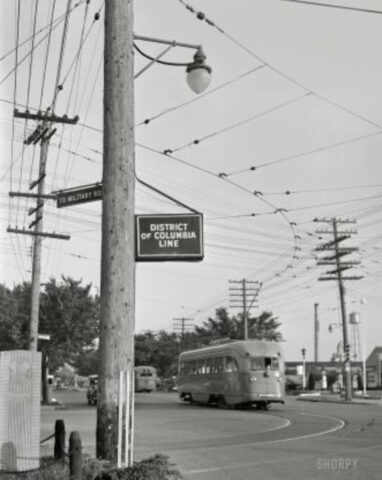When There Were Boundaries

(The larger of the two small signs affixed to this utility pole marks the boundary of the District of Columbia. Marlow sent it along this morning with only a mildly exasperated observation on how things change. In this image, there is a bus line that operated in a satisfactory manner on a street that defined one boundary of the District. On the same boundary today- one we visited frequently on Military Road- things appear to have changed. Pretty dramatically, if what they say on the local news is true.)
This New Year is coming out of the Holidays with some bold revelations. Our minds swirl with them. The morning production meeting of the Writer’s Section featured some discussion of the health issues going on. Topic was the dramatic increase in reported myocarditis events. That led to references about the blood clot adventure that nearly took one of us away. That transitioned rapidly into there strange reprise of “classified information” improperly stored that seems both similar and dramatically different than the last time we saw documents strewn on the floor of a Presidential Office.
Then came some new details on the murder of another President sixty years ago. Why it is news today, and why some of the information is still classified. NBC news reports “only 3% of the documents of the Warren Commission” remain classified. Most of us are a little curious about that, since six decade ought to have covered the sources-and-methods of 1963 by now. So, the conversation veered off into the discussion Marlow started about boundaries.
It appears that some fairly significant lines have been crossed lately. That made Marlow’s contribution this morning both timely and striking. He sent in an image that hit all kinds of hot buttons here at Socotra House. His only words included with the picture were simple and stark: “Ah — long ago memory from a time when there were boundaries.”
We remember this particular Boundary well. It was twenty years ago. Chairman Vic was in a moment of transition in his raucous life. He told us he felt a little disoriented at the time, and had moved from bustling Fairfax Count Virginia to living “close in” to government and private sector employment with the United States government. There was work at the Defense Intelligence Agency Headquarters on Bolling Air Force Base. These involved frequent trips across the Potomac River to “Washington DC SE.” These were mixed with duty at the Pentagon in Arlington or at the Phone Company office in the old Greyhound Bus Station on New York Avenue downtown.
Things change, of course. The proud Air Force Base has been transformed into something else. It is now “Joint Base Bolling-Anacostia.” Military installations were once divided in two great heaps, one managed by the War Department and the other by the Department of the Navy. The massive reorganization of the two Departments into one, while adding an Air Force occurred in 1947. The intricacies of that massive transformation appears as a theme in the recent publication of the Chairman’s trilogy of books about those times:

From left to right and below are “Cocktails With the Admiral,” “Voyage to the CROSSROADS,” and “The Last Cold War Cruise”
There is still some excitement about that, but Marlow’s picture caused more discussion about the boundaries that define our busy little lives in a place that was Capital of the Free World. If you took the classes schools used to teach about civics and history you will recall that the former colonies of Maryland and Virginia contributed parts of their territory to create a thing called “The District of Columbia.” It was intended to provide a capital for the new government created from the former colonial possessions of the Royal Family of Great Britain.
Convenience for many of those known as “the Founding Fathers” was a factor, since General Washington had to take an extended carriage ride of nearly 14 miles from his villa at Mount Vernon to the new Capitol complex to the north. To mark the extent of the new jurisdiction, the District was bounded by a square ten miles in length on each side. The Potomac River split it down the middle. The very first monuments of the new Republic authorized by the Congress were the boundary stones of the District. The square was an upended affair, with the corners oriented north and south. A proud stone was placed at each one mile-interval along the lines of authority, forty in all.
There was a time when they all stayed put. The story of the 38 remaining examples of those monuments (and how to see them) became a minor but extended adventure shared with a cohort of urban adventurers. Then, there were parts of the District that were less safe than others. Today? Times have changed along with the boundaries. Finding them all- the 38 still in place plus the two former locations- was a special adventure that enabled some unique views of an equally unique city.
The portion of the District on the west shores of the Potomac became ungovernable over just a few decades. That part was returned to the Commonwealth of Virginia. The story of the new boundaries had a few quirks. The District has jurisdiction that spans the flow of the broad brown river, and the Pentagon in Virginia actually abuts the waters not divided down the middle, but at the highest reach of water on the Virginia shore. There is much more to it all, but that would require telling more of the tale to provide context. There are also indications that seeing the Stones of the District might actually be a little more dangerous than it used to be.
That discussion led directly to the production of an old product from Socotra House. It was handed around the circle with a certain ironic relevance, since some of us had been on the collected adventures that produced it. But as Marlow said, “there was a time when there were boundaries.” They seem to be changing at the moment. To help you prepare, this old guidebook may have some minor utility. Of course, it might not. Boundaries seem to change, you know?

Copyright 2023 Vic Socotra
www.vicsocotra.com
